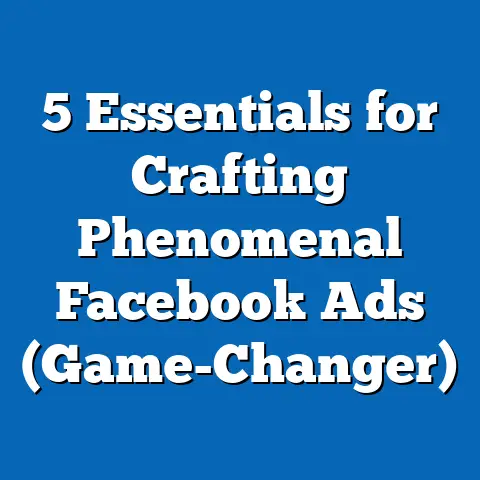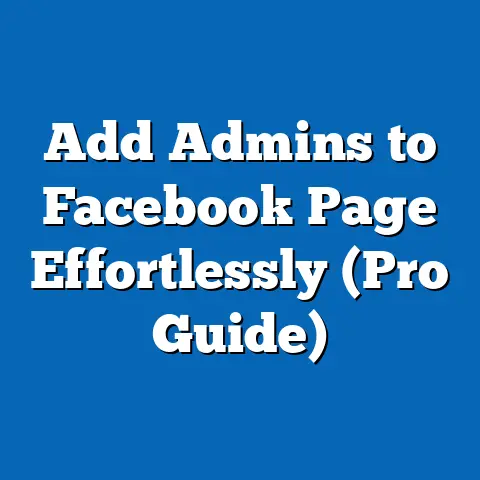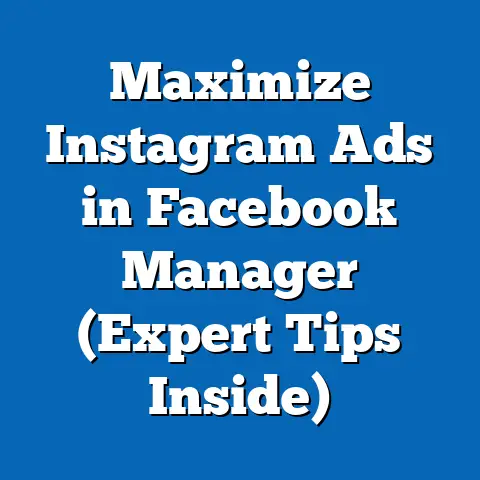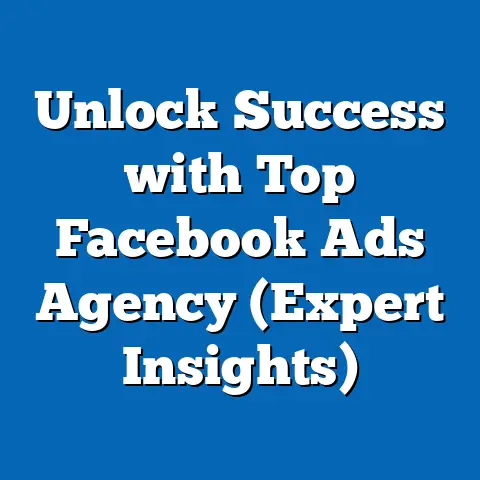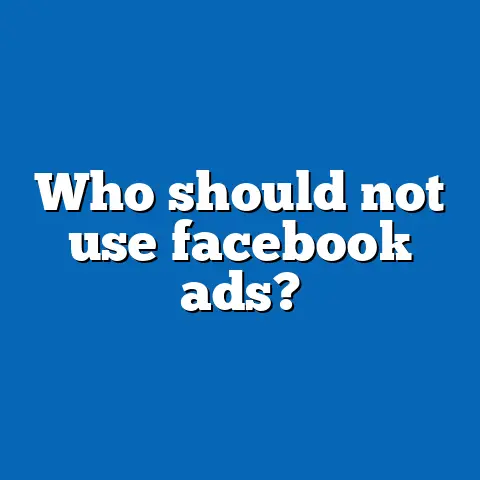Boost Engagement with High-Impact Facebook Ads (Pro Tactics)
Are your Facebook ads falling flat in a sea of digital noise, failing to capture the attention they deserve? You’re not alone. In today’s hyper-competitive digital landscape, simply having a Facebook ad isn’t enough. You need engaging Facebook ads – ads that resonate with your audience, spark conversations, and ultimately drive results.
Engagement is the lifeblood of successful Facebook advertising. It’s what transforms passive viewers into active participants, fostering brand loyalty and significantly impacting your bottom line. Higher engagement translates to increased brand visibility, improved ad relevance scores (leading to lower ad costs), and ultimately, more conversions. Think of it this way: an ad that gets liked, shared, and commented on is essentially free advertising, extending your reach far beyond your initial budget.
But how do you cut through the clutter and create Facebook ads that truly captivate? This article delves into proven, high-impact tactics that can dramatically boost engagement and transform your Facebook advertising strategy. We’ll move beyond basic tips and tricks, focusing on the psychology behind engagement, the power of compelling visuals, and the strategic use of Facebook’s advanced targeting options. Get ready to unlock the secrets to crafting Facebook ads that not only grab attention but also forge meaningful connections with your target audience. We’ll cover everything from crafting irresistible ad copy to leveraging the latest ad formats, all designed to drive meaningful interactions and achieve your business goals. Let’s dive in!
2. Understanding Facebook Ads and Engagement (Approx. 700 words)
So, what exactly constitutes a “high-impact” Facebook ad? It’s more than just pretty pictures and clever slogans. A high-impact ad is one that effectively captures the attention of its target audience, resonates with their needs and desires, and prompts them to take a specific action, whether it’s liking a post, sharing it with friends, leaving a comment, clicking a link, or making a purchase. It creates a genuine connection.
To truly understand engagement, we need to delve into the psychology behind why people interact with content on social media. People are drawn to content that is:
- Relevant: It addresses their specific needs, interests, or pain points.
- Emotional: It evokes feelings, whether it’s humor, inspiration, empathy, or excitement.
- Valuable: It offers something of worth, such as information, entertainment, or a solution to a problem.
- Socially Acceptable: It aligns with their personal brand and the image they want to project online.
Understanding these psychological triggers is crucial for crafting ads that connect with your audience on a deeper level.
Measuring Engagement: The Key Metrics
Engagement on Facebook is measured through a variety of metrics. Understanding these metrics is essential for tracking the success of your campaigns and identifying areas for improvement. Key metrics include:
- Likes/Reactions: These indicate a basic level of appreciation and agreement with your ad.
- Comments: Comments represent a higher level of engagement, indicating that users are interested enough to share their thoughts and opinions.
- Shares: Shares are a powerful indicator of engagement, as they demonstrate that users find your ad valuable enough to share with their own networks.
- Click-Through Rate (CTR): CTR measures the percentage of users who click on your ad after seeing it. A high CTR indicates that your ad is relevant and engaging to your target audience.
- Engagement Rate: This metric calculates the percentage of people who saw your ad and then engaged with it in some way (like, comment, share, click).
- Cost Per Engagement (CPE): This measures how much you are paying for each engagement on your ad. Lower is better.
The Significance of Ad Relevance and Targeting
Ad relevance and targeting are fundamental to achieving high engagement. Facebook uses a “relevance score” (though not explicitly shown anymore, the algorithm still uses similar factors) to determine how well your ad matches the interests of your target audience. A higher relevance score translates to lower ad costs and increased visibility.
Targeting ensures that your ad is shown to the right people at the right time. By leveraging Facebook’s advanced targeting options, you can reach specific demographics, interests, behaviors, and even custom audiences based on your existing customer data. Showing your ad to the wrong audience is a surefire way to waste your budget and generate zero engagement. A well-targeted ad is far more likely to resonate with its audience and generate meaningful interactions.
3. Crafting Compelling Ad Copy (Approx. 800 words)
Your ad copy is the voice of your brand on Facebook. It’s your opportunity to grab attention, communicate your message, and persuade users to take action. Writing persuasive and engaging ad copy requires a strategic approach that considers your target audience, your offer, and the overall tone and style of your brand.
Strategies for Writing Persuasive Ad Copy:
- Use Emotional Triggers: Tap into your audience’s emotions by using words and phrases that evoke feelings of excitement, happiness, fear, or urgency. For example, instead of saying “Learn new skills,” try “Unlock your full potential and achieve your dreams.”
- Tell a Story: Stories are a powerful way to connect with your audience on a personal level. Share a relatable anecdote or a customer success story to illustrate the benefits of your product or service.
- Highlight Benefits, Not Just Features: Focus on how your product or service will improve your audience’s lives. Instead of saying “Our software has advanced analytics,” try “Gain valuable insights and make data-driven decisions that will grow your business.”
- Create a Sense of Urgency and Scarcity: Encourage users to take action immediately by creating a sense of urgency or scarcity. For example, “Limited-time offer – ends tonight!” or “Only 10 spots left!”
- Ask Questions: Engage your audience by asking questions that prompt them to think about their needs and desires. For example, “Are you tired of feeling stressed and overwhelmed?”
- Use Power Words: Incorporate power words like “free,” “new,” “easy,” “guaranteed,” and “proven” to make your ad copy more compelling.
- Keep it Concise and Clear: Facebook users are bombarded with information, so it’s important to keep your ad copy concise and easy to understand. Get straight to the point and avoid jargon or technical terms.
- Include a Clear Call-to-Action (CTA): Tell users exactly what you want them to do, whether it’s “Shop Now,” “Learn More,” “Sign Up,” or “Get a Free Quote.” Make your CTA prominent and easy to click.
Understanding Your Target Audience:
Tailoring your ad copy to your target audience is crucial for maximizing engagement. Before you start writing, take the time to research your audience and understand their demographics, interests, behaviors, and pain points. What are their biggest challenges? What are their aspirations? What kind of language do they use?
Use this information to create ad copy that speaks directly to their needs and desires. For example, if you’re targeting young professionals, you might use a more casual and conversational tone. If you’re targeting senior citizens, you might use a more formal and respectful tone.
Examples of Successful Ad Copy:
-
Example 1: (E-commerce – Clothing)
4. Visuals that Captivate (Approx. 800 words)
In the fast-paced world of social media, visuals are king. They are the first thing people notice when scrolling through their newsfeeds, and they play a crucial role in capturing attention and driving engagement. A compelling visual can stop users in their tracks and entice them to learn more about your product or service. A bad visual can make your ad instantly ignored.
The Role of Visuals in Facebook Ads:
- Attract Attention: High-quality visuals instantly grab the attention of users who are scrolling through their newsfeeds.
- Communicate Your Message: Visuals can convey complex information quickly and effectively.
- Evoke Emotions: Visuals can evoke emotions that resonate with your target audience.
- Enhance Brand Recognition: Consistent use of branding elements in your visuals helps to enhance brand recognition.
- Drive Clicks and Conversions: Compelling visuals can encourage users to click on your ad and take the desired action.
Types of Visuals:
- Images: Images are a versatile option for Facebook ads. Use high-quality, visually appealing images that are relevant to your product or service. Consider using lifestyle images that show your product in use.
- Videos: Videos are a highly engaging format that can capture attention and communicate your message effectively. Short, impactful videos are ideal for Facebook ads. Consider using videos that showcase your product, tell a story, or provide valuable information.
- Carousels: Carousel ads allow you to showcase multiple images or videos in a single ad unit. This format is ideal for showcasing a range of products, highlighting different features of a single product, or telling a story.
- GIFs: GIFs are short, animated images that can add a touch of humor and personality to your ads.
Guidelines for Creating Eye-Catching Visuals:
- Use High-Quality Images and Videos: Blurry or pixelated visuals will turn users off.
- Optimize for Mobile: Ensure that your visuals look good on mobile devices, as the majority of Facebook users access the platform on their smartphones.
- Use Bright Colors and Contrasting Elements: Bright colors and contrasting elements can help your visuals stand out in the newsfeed.
- Incorporate Branding Elements: Include your logo, brand colors, and fonts in your visuals to enhance brand recognition.
- Keep it Simple: Avoid overcrowding your visuals with too much text or too many elements.
- Test Different Visuals: A/B test different visuals to see which ones perform best with your target audience.
Case Studies of Brands Using Visuals to Boost Engagement:
- Case Study 1: GoPro: GoPro is known for its stunning action videos that showcase the capabilities of its cameras. By sharing user-generated content and creating visually compelling videos, GoPro has built a massive following on Facebook and driven significant engagement.
- Case Study 2: Airbnb: Airbnb uses beautiful photos of its properties to entice users to book accommodations. By showcasing the unique and desirable aspects of its listings, Airbnb has been able to drive bookings and increase revenue.
- Case Study 3: Dollar Shave Club: Dollar Shave Club’s humorous and quirky videos have helped the company stand out in the crowded shaving market. By creating entertaining content that resonates with its target audience, Dollar Shave Club has built a loyal following and driven significant engagement.
5. Utilizing Facebook’s Targeting Capabilities (Approx. 700 words)
Facebook’s targeting capabilities are a game-changer for advertisers. They allow you to reach the exact audience you want to reach, ensuring that your ads are seen by people who are most likely to be interested in your product or service. This, in turn, leads to higher engagement rates and a better return on your investment.
Advanced Targeting Options:
- Demographics: Target users based on age, gender, location, education, relationship status, and other demographic factors.
- Interests: Target users based on their interests, hobbies, and passions. Facebook gathers this data from the pages and groups that users like and follow.
- Behaviors: Target users based on their online and offline behaviors, such as purchase history, travel habits, and device usage.
- Custom Audiences: Create custom audiences based on your existing customer data, such as email lists, website visitors, and app users. This allows you to retarget users who have already interacted with your brand.
- Lookalike Audiences: Create lookalike audiences based on your existing custom audiences. Facebook will identify users who share similar characteristics and behaviors with your existing customers.
- Detailed Targeting: Combine multiple targeting options to create highly specific audiences. For example, you could target women aged 25-34 who are interested in fashion and live in New York City.
Leveraging Custom Audiences:
Custom audiences are a powerful tool for retargeting users who have already interacted with your brand. You can create custom audiences based on:
- Website Traffic: Target users who have visited your website.
- Email Lists: Upload your email list to Facebook and target those users with your ads.
- App Activity: Target users who have downloaded and used your app.
- Engagement on Facebook: Target users who have liked your page, watched your videos, or engaged with your posts.
Creating Lookalike Audiences:
Lookalike audiences are a great way to expand your reach and find new customers who are similar to your existing customers. When creating a lookalike audience, Facebook will analyze the characteristics and behaviors of your source audience (e.g., your existing customers) and identify other users who share similar traits.
A/B Testing Targeting Strategies:
It’s important to A/B test different targeting strategies to identify what works best for your business. Try testing different demographic combinations, interest categories, and behavior options. Monitor your results closely and adjust your targeting accordingly. For example, you might find that targeting users based on their interests yields better results than targeting them based on their demographics. Or you might find that a lookalike audience performs better than a custom audience. The key is to experiment and learn what resonates most with your target audience.
6. Engagement-Driven Ad Formats (Approx. 600 words)
Facebook offers a variety of ad formats, each with its own strengths and weaknesses when it comes to driving engagement. Choosing the right ad format can significantly impact the success of your campaigns.
Popular Engagement-Driven Ad Formats:
- Image Ads: Simple yet effective, image ads are a great way to showcase your product or service with a visually appealing image.
- Video Ads: Videos are highly engaging and can capture attention quickly. Use video ads to tell a story, demonstrate your product, or provide valuable information.
- Carousel Ads: Carousel ads allow you to showcase multiple images or videos in a single ad unit. This format is ideal for showcasing a range of products, highlighting different features of a single product, or telling a story.
- Collection Ads: Collection ads are designed for e-commerce businesses. They allow you to showcase a catalog of products in a visually appealing format.
- Lead Ads: Lead ads make it easy for users to submit their contact information without leaving Facebook. This format is ideal for generating leads for your business.
- Instant Experience Ads (formerly Canvas Ads): Instant Experience ads provide a full-screen, immersive experience for users on mobile devices. This format is ideal for telling a story, showcasing your brand, or providing valuable information.
- Stories Ads: Facebook Stories ads are short, full-screen videos or images that appear between users’ Stories. They are highly engaging and can reach a large audience.
- Poll Ads: Poll ads allow you to ask your audience a question and let them vote on the answer. This format is great for driving engagement and gathering feedback.
Creative Utilization for User Interaction and Feedback:
- Stories Ads: Use interactive stickers in Stories ads, such as polls, quizzes, and question stickers, to encourage user interaction.
- Poll Ads: Use poll ads to gather feedback on your products or services, or to ask your audience about their preferences.
- Collection Ads: Use collection ads to showcase a range of products and make it easy for users to browse and purchase them.
- Video Ads: Create videos that are entertaining, informative, or emotionally engaging to capture attention and drive engagement.
- Carousel Ads: Tell a story with your carousel ads by showcasing different aspects of your product or service in each image or video.
7. Leveraging Retargeting Strategies (Approx. 600 words)
Retargeting is a powerful tactic for boosting engagement by re-engaging users who have previously interacted with your brand. These are the people who have already shown some level of interest, making them much more likely to convert than cold traffic.
The Concept of Retargeting:
Retargeting involves showing ads to users who have previously visited your website, interacted with your Facebook page, watched your videos, or engaged with your ads. The goal is to remind them of your brand and encourage them to take the desired action, whether it’s making a purchase, signing up for a newsletter, or downloading an app.
Setting Up Retargeting Campaigns:
To set up retargeting campaigns, you’ll need to install the Facebook Pixel on your website. The Facebook Pixel is a small piece of code that tracks user activity on your website and allows you to create custom audiences based on that activity.
You can then create retargeting campaigns that target users who have visited specific pages on your website, added items to their cart but didn’t complete the purchase, or viewed your products but didn’t add them to their cart.
Crafting Retargeting Ads:
Your retargeting ads should be tailored to the specific actions that users have taken on your website or Facebook page. For example, if a user added an item to their cart but didn’t complete the purchase, you could show them an ad that reminds them of the item and offers a discount or free shipping to encourage them to complete the purchase.
Tips for Effective Retargeting Ads:
- Personalize Your Ads: Use personalized messaging that addresses the specific actions that users have taken on your website or Facebook page.
- Offer Incentives: Offer discounts, free shipping, or other incentives to encourage users to take the desired action.
- Use Compelling Visuals: Use high-quality visuals that are relevant to the products or services that users have viewed.
- Use Clear Calls-to-Action: Tell users exactly what you want them to do, whether it’s “Shop Now,” “Learn More,” or “Sign Up.”
- Frequency Capping: Set a frequency cap to limit the number of times that users see your ads. This will prevent ad fatigue and ensure that your ads remain effective.
8. Analyzing and Optimizing Campaigns (Approx. 500 words)
Analyzing your Facebook ad performance is crucial for understanding what’s working and what’s not. Data-driven insights are the key to optimizing your campaigns and maximizing your return on investment.
The Importance of Analytics:
Analytics provide valuable information about your ad performance, such as:
- Reach: The number of people who saw your ad.
- Impressions: The number of times your ad was displayed.
- Clicks: The number of times people clicked on your ad.
- Click-Through Rate (CTR): The percentage of people who clicked on your ad after seeing it.
- Engagement: The number of likes, comments, shares, and other interactions with your ad.
- Conversions: The number of people who took the desired action after clicking on your ad (e.g., making a purchase, signing up for a newsletter).
- Cost Per Result (CPR): The average cost of achieving a specific result (e.g., a click, a conversion).
Analyzing Ad Performance Using Facebook Ads Manager:
Facebook Ads Manager provides a comprehensive suite of tools for analyzing your ad performance. You can use Ads Manager to track your key metrics, identify trends, and compare the performance of different ads and campaigns.
Techniques for Optimizing Campaigns:
- A/B Testing: A/B test different versions of your ads to see which ones perform best. Try testing different headlines, images, ad copy, and calls-to-action.
- Targeting Refinement: Refine your targeting based on your ad performance data. Identify the demographics, interests, and behaviors that are most likely to convert and focus your efforts on those segments.
- Budget Optimization: Allocate your budget to the ads and campaigns that are performing best.
- Creative Refresh: Regularly refresh your ad creative to keep your ads engaging and prevent ad fatigue.
- Landing Page Optimization: Ensure that your landing pages are optimized for conversions. Make sure that your landing pages are relevant to your ads, easy to navigate, and contain clear calls-to-action.
9. Conclusion (Approx. 300 words)
In conclusion, boosting engagement with high-impact Facebook ads is a multifaceted process that requires a strategic approach. From crafting compelling ad copy that resonates with your audience to utilizing captivating visuals and leveraging Facebook’s advanced targeting capabilities, every element plays a crucial role in driving meaningful interactions and achieving your business goals.
We’ve explored the power of engagement-driven ad formats, the effectiveness of retargeting strategies, and the importance of analyzing and optimizing your campaigns based on data insights. By implementing these tactics, you can transform your Facebook advertising efforts and see a significant improvement in your results.
Remember, success on Facebook is not just about creating ads; it’s about creating connections. It’s about understanding your audience, speaking their language, and offering them value that resonates with their needs and desires.
Don’t be afraid to experiment, to test new approaches, and to learn from your results. The world of Facebook advertising is constantly evolving, and the most successful marketers are those who are willing to adapt and innovate.
So, go forth and implement these strategies. Transform your Facebook ads from passive impressions into active conversations. Watch as your engagement soars, your brand visibility increases, and your business thrives. The power to create truly impactful Facebook ads is now in your hands. Start creating!

